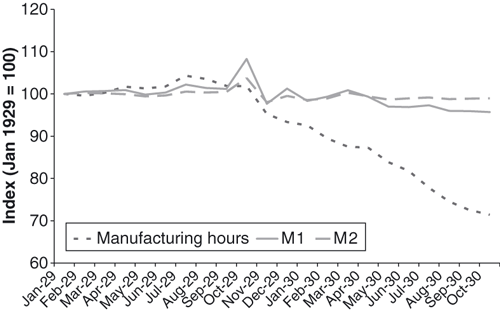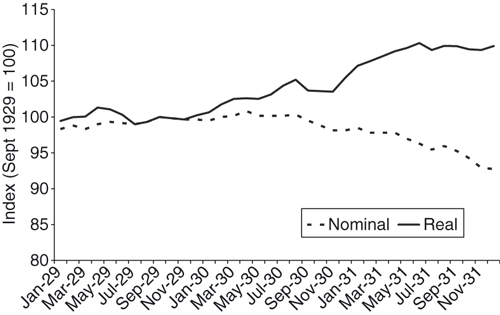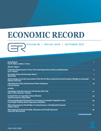Understanding Economic Crises: The Great Depression and the 2008 Recession
Abstract
Economic crises, involving large and persistent declines in output and employment, are puzzles, particularly in developed countries with economies that typically function at a high level. This article analyses the Great Depression and the 2008 recession using recent developments in business cycle diagnostic procedures, and finds that the key to both episodes is understanding labour market distortions that resulted in the marginal product of labour being much higher than the marginal rate of substitution between consumption and leisure. This finding stands in sharp contrast to the received wisdom, which focuses on the role of banking crises and capital market distortions. The article also discusses possible hypotheses for these labour market distortions.
I Introduction
Depressions – large and persistent declines in market economic activity – are the economic equivalents of a classic ‘whodunit’ novel. Like a whodunit, a depression features a major crime: an economy is levelled, and there are typically a number of interesting suspects who may have contributed to the crime. But above all, depressions, like whodunits, are a mystery. Depressions are mysterious from the perspective of standard economic theory, particularly in countries that should not have them; countries such as Australia, the United States and other highly developed nations that feature well-functioning economies and relatively efficient institutions. So what makes good economies go bad?
This article assesses some features of depressions and crises, with a focus on the most infamous, the Great Depression, and the most recent, the crisis and recession of 2008. I organise the article around understanding what is known about these events, and what research remains to be done. To do this, I will highlight some key facts about both episodes and discuss how these facts suggest potentially interesting future research avenues for understanding these pathologies.
I will conclude that theories of labour market distortions, particularly theories for understanding why the marginal product of labour substantially exceeds the marginal rate of substitution between consumption and leisure during these episodes, are the key to understanding crises and depressions. This differs from the view that capital market failures associated with banking crises are the major causal factors in depressions.
II The Mystery of the Great Depression
It is probably surprising that I suggest depressions – particularly the Great Depression and the recession of 2008 – are mysteries. After all, there is a textbook view that the Depression was the consequence of worldwide banking crises and monetary contraction, and there is also a widely held view that the recession of 2008 was the consequence of a worldwide financial crisis.
But thus far there are no economic models to my knowledge, based on these factors, which are capable of quantitatively accounting for these episodes and that at the same time are consistent with other facts. I now turn to discussing some of these facts and their implications.
I begin with the US Great Depression. Figure 1 shows data on the timing of the depression, and the timing of banking crises and monetary contraction in the United States. There is a textbook view that the depression began as a ‘garden variety’ recession, and that monetary contraction and banking panics turned it into a Great Depression. But Figure 1 shows that this view is incorrect. The figure shows hours worked in the manufacturing sector, and two measures of money, M1 and M2, between January 1929 and October 1930. The graph ends in October 1930, which is before any of the banking crises identified in the literature.

Manufacturing Hours and Money Supply Before First Banking Crisis
The figure shows that the Great Depression was indeed ‘Great’ before the banking crises and the monetary contraction that figure so prominently in Friedman and Schwartz’s (1963) analysis of the depression as well as Bernanke’s (1983). Specifically, hours worked decline around 30 per cent, with virtually no drop in either measure of the money supply, and without any significant financial distress. Moreover, some (Wicker, 1996) argue that the first banking crises identified by Friedman and Schwartz did not have any macroeconomic consequences, as interest rates and measures of financial intermediation services changed very little.
In addition, although it is true that the number of banks in the United States declined by about 40 per cent between 1929 and 1933, these banks on average were very small. Cole and Ohanian (1999) showed that the fraction of deposits in these banks between 1930 and 1933 were 1.7, 2, 4.3 and 11 per cent, respectively.
These data show that the depression banking crises were small on average, and that they occurred well after the depression was very deep. This implies that the contribution of banking crises to the depression remains an open question.
But if the depression was ‘Great’ prior to monetary contraction and banking panics, then what did initiate it? The evidence I have examined indicates that the prime suspect was a distortion to industrial labour markets that kept wages far above market-clearing levels, which resulted in a dramatic decline in employment and output. Specifically, nominal industrial wages behaved very differently during the early stages of the Great Depression than during other downturns and deflations. Nominal and real wages during the early stages of the depression initially increased as industrial employment plummeted.
Figure 2 shows nominal and real manufacturing wages during the depression. The key puzzle in these data is why did not wages decline in response to rapidly falling employment? To help benchmark the industrial labour market, I also examine the farm labour market, which like manufacturing, accounted for about 25 per cent of employment in 1929. In contrast to the industrial sector, the farm sector behaved very differently. Farm employment remained near trend through 1933, with declining nominal and real wages.

Nominal and Real Manufacturing Wages
These data show that the depression was very asymmetric across sectors, in that industry collapsed, whereas employment and real output in the farm sector was roughly unaffected. This suggests an industry-specific distortion that prevented the labour market from clearing, but that did not impact the farm sector.
My explanation for this industrial labour market failure is a large change in industrial labour policy initiated by President Hoover in late 1929 (Ohanian, 2009). Specifically, in November 1929, Hoover met with a number of industrial leaders, including Henry Ford, of Ford Motor Company, Alfred Sloan, of General Motors, and Elbert Gary of US Steel. Hoover advised these executives that their profits were at all time highs, that most workers had not seen wage increases and asked them to maintain their current nominal wage rates. Hoover advised the industry executives that this would help him keep peace with labour. In turn, Hoover stated that if industry would agree to maintain nominal wages, then he would advise labour to withdraw wage demands. Hoover was pleased that industry agreed to maintain wages, and that labour withdrew wage demands. For nearly 2 years, major industry kept their pledge and held nominal wages fixed, despite the fact that Hoover would not support industry requests for wage cuts that were proportional to the cost of living changes.
As prices fell, deflation raised the real manufacturing wage, which along with declining productivity substantially raised the price of labour. It was not until the Fall of 1931 when Hoover rejected requests for government aid to industry in the form of explicit cartelisation, that major employers began cutting wages. But at this point, industrial hours had already declined by 50 per cent. So why did the depression continue throughout the remainder of the 1930s? Cole and Ohanian (2004) present theory and evidence that it was because of the continuation and deepening of these types of policies by President Roosevelt.
III The Puzzles of the 2008 Recession
The 2008 recession was more plausibly initiated by financial crisis than the Great Depression. Unlike the 1930s, in which banking panics did not occur until the depression was well under way, and in which many of the banks involved were small, the 2008 crisis was much larger and temporally coincident with the acceleration of the recession beginning in Fall 2008. Specifically, the share of deposits in commercial banks that received government aid through the Troubled Asset Relief Program (TARP), that otherwise presumably would have failed, was more than 50 per cent, compared with the much smaller numbers cited before for the 1930s. Moreover, the crisis came to a head in September and October of 2008, which roughly coincides with accelerating job loss in a recession that began fairly mildly at the beginning of 2008.
So what are the puzzles of this recession? The mystery of 2008 – or at least a major puzzle – relates to two issues. The first is that the recession of 2008 does not necessarily look like an economy impacted by a financial crisis, at least from the perspective of standard growth theory. Specifically, I have examined the 2008 recession using recently developed diagnostic procedures based on estimated deviations in the equilibrium conditions of standard growth theory (Cole & Ohanian, 2002; Chari et al., 2007).
The main feature of these diagnostics is that any deviation in output, consumption, investment or employment from steady-state growth values must be accompanied by some distortion in at least one of the equations that characterise the growth model. A common distortion in many US and other recessions is a productivity distortion, as in the real business cycle literature initiated by Kydland and Prescott (1982). But the 2008 US recession has no distortion in productivity or any other distortions with the exception of a very large deviation in the standard household equilibrium condition that equates the marginal product of labour with the marginal rate of substitution between consumption and leisure.
As in the Great Depression, the marginal product of labour during the 2008 crisis substantially exceeds the marginal rate of substitution. And here lies the puzzle. Financial shocks within standard business cycle models that feature financial market imperfections, such as Carlstrom and Fuerst (1997), and Bernanke et al. (1999), do not impact this labour market condition. Instead, they impact the Euler equation by driving a wedge between the intertemporal marginal rate of substitution and the net return to capital investment. But the Euler equation during the 2008 US recession, as well as this recession in many other countries holds almost exactly.
This suggests that if the recession is primarily the consequence of the financial crisis, then it appears to be operating through labour market channels that distort the relationship between the marginal rate of substitution and the marginal product of labour. But there is presently very little in the way of models with financial market imperfections that are consistent with these findings, and probably none that on the basis of financial crisis alone can account for the continuation of the recession long after the worst of the financial crisis was over.
A second reason that the 2008 recession is puzzling is that there are other temporally coincident factors that a number of economists indicate played a major role, including Taylor (2010), Mulligan (2010), Cochrane and Zingales (2009) and Jagannathan et al. (2009). Specifically, these economists have all argued that government policies, including policies adopted in September and October of 2008, such as the TARP, had a big impact. Specifically, these economists suggest that government actions in dealing with the crisis damaged the economy.
Taylor uses a variety of high frequency data to help identify the independent contribution of policies on the recession and also its impact on the deepening of the financial crisis. Taylor shows that some interest rates spreads, and both US and foreign stock prices, deteriorated much more rapidly around the time of the TARP announcement and of President Bush’s warning of the possibility of a Great Depression if TARP was not passed, than around the time of the Lehman bankruptcy or other significant events in the financial crisis. Moreover, Taylor (2009) tracks daily sales at target department stores during Fall 2008 to determine when consumer spending broke from the very modest trend decline that has been occurring before that. The data show little immediate impact of the Lehman bankruptcy of 15 September, a key event in discussions of the evolution of the crisis. But sales drop substantially around 19 September, immediately following the announcement of TARP, and continue to decline quickly thereafter.
Taylor concludes from this and related analyses that government policies contributed significantly to the recession of 2008. However, there are few, if any, models currently available for analysing the contribution of these factors.
IV Conclusions
The key to understanding both the depression of the 1930s and the recession of 2008 is developing theories of labour market distortions that can account for why the marginal product of labour significantly exceeded the marginal rate of substitution between consumption and leisure. I have developed theory and presented evidence that the labour policies of Herbert Hoover are a candidate factor for the Great Depression (Ohanian, 2009), but theories along these lines for the recession of 2008 remain an open question.
There are, however, research programmes currently underway aimed at addressing this issue, including work by Arellano et al. (2010), Jermann and Quadrini (2009) and Mulligan (2010). More broadly, I am hopeful that our understanding of crises and depressions will advance considerably in the coming years with the continued application and development of theories that can address these pathologies. Although future research along these lines may not be able to prevent financial crises, it can have the potential to significantly reduce the severity of macroeconomic fluctuations associated with crises.




